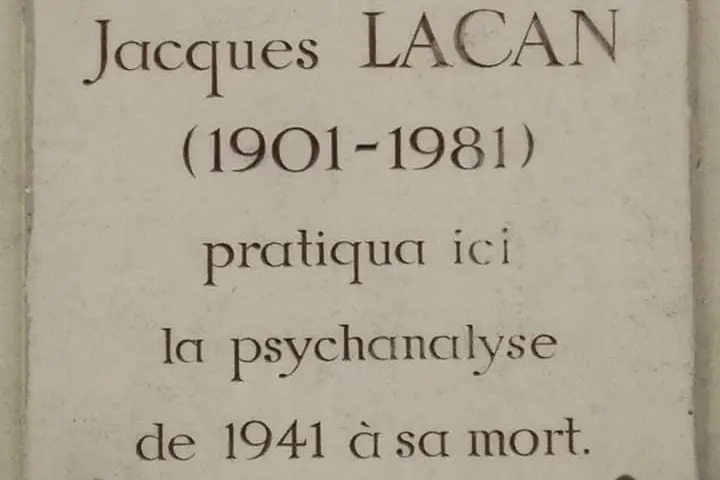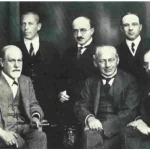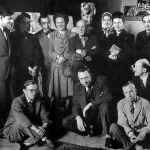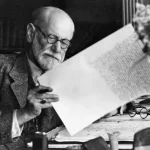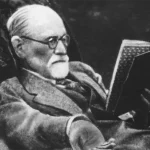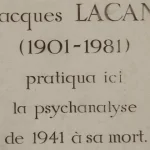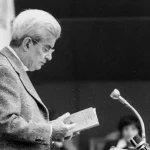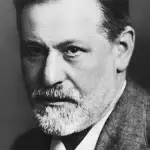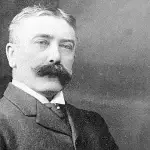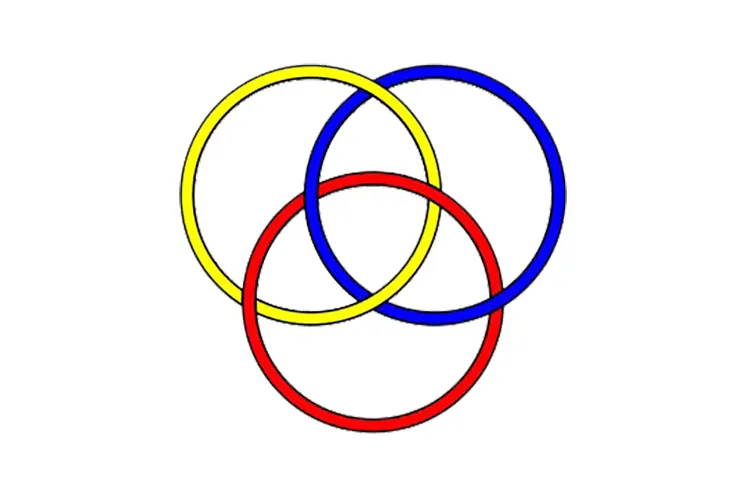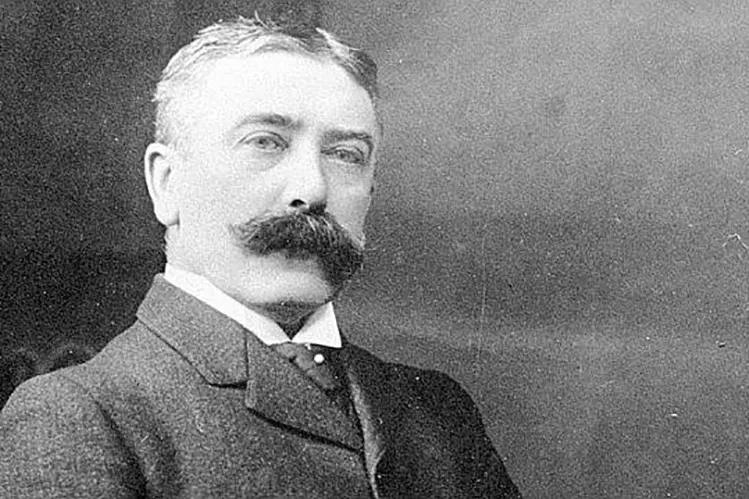Jacques-Marie-Émile Lacan (April 13, 1901 – September 9, 1981) was born in a family of solid Catholic tradition, and was educated at a Jesuit school. After completing his baccalauréat he commenced studying medicine and later psychiatry. In 1927, he commenced clinical training and began to work at psychiatric institutions, meeting and working with (amongst others) the famous psychiatrist Clerambault. His doctoral thesis, on paranoid psychosis, was passed in 1932. In 1934, he became a member of La Societe Psychoanalytique de Paris (SPP), and commenced an analysis with Rudolph Loewenstein lasting until the outbreak of the war. Lacan was very active in the world of Parisian writers, artists and intellectuals of the time: he was a friend of André Breton, Salvador Dalí and Picasso and attended the mouvement Psyché founded by Maryse Choisy. He made contributions to several Surrealist publications and was present at the first public reading of James Joyce’s Ulysses. In his studies he had a particular interest in the philosophic work of Karl Jaspers and Martin Heidegger and, alongside many other Parisian intellectuals of the time, he also attended the famous seminars on Hegel given by Alexandre Kojève.
Lacan presented his first analytic paper on ‘The Mirror Phase’ at the 1936 Congress of the International Psychoanalytical Association in Marienbad. He was called up to serve in the French army after the German occupation of France and was posted to the Val-de-Grâce military hospital in Paris. After the end of the war, Lacan visited England for a five week study trip, meeting English analysts Wilfred Bion and John Rickman. He was much influenced by Bion’s analytic work with groups and this contributed to his own later emphasis on study groups (in France, cartels) as a structure with which to advance theoretical work in psychoanalysis.
In 1951 Lacan started to hold a weekly seminar at the St-Anne Hospital (Paris), urging what he described as ‘a return to Freud’ and, in particular, to Freud’s concentration upon the linguistic nature of psychological symptomatology. Very influential in Parisian cultural life as well as in psychoanalytic theory and clinical practice, the seminars drew large crowds and continued for nearly thirty years.
Lacan was a member of the Société Parisienne de Psychanalyse (SPP), which was a member body of the International Psychoanalytical Association (IPA). In 1953, after a disagreement about analytic practice methods, Lacan and many of his colleagues left the SPP to form a new group the Société Française de Psychanalyse (SFP). One of the consequences of this move was to deprive the new group of membership within the IPA. In the following years a complex process of negotiation was to take place to determine the status of the SFP within the IPA. Lacan’s practice, with his controversial innovation of variable-length sessions, and the critical stance he took towards much of the accepted orthodoxy of psychoanalytic theory and practice led, in 1963, to a condition being set by the IPA that the registration of the SFP was dependent upon Lacan being removed from the list of training analysts with the organisation. Lacan refused such a condition and left the SFP to form his own school which became know as the École Freudienne de Paris (EFP). Leaving the St-Anne Hospital where he had delivered his seminar up to this point Lacan began to give it instead at the elite higher education establishment the École Normale Supérieure. Lacan began to set forth his own teaching on psychoanalysis to an audience of colleagues who had joined him from the SFP. His lectures also attracted many of the École Normale’s students.
Many students of Lacan became important psychoanalysts and/or wrote influential contributions to philosophy and other fields. Michel Foucault, Jacques Derrida, Louis Althusser, Luce Irigaray, Jean Laplanche, and even Claude Levi-Strauss, for example, all attended Lacan’s seminars at some point. Lacan’s first seminar in 1964 was later published in English as The Four Fundamental Concepts of Psychoanalysis. Lacan continued to deliver his public exposition of analytic theory and practice for the next seventeen
The ‘Return to Freud’
Following Freud’s death, psychoanalytic practice split into many differing schools of thought. Against the backdrop of these divergent currents of psychoanalytic theory, Lacan called for a ‘return to Freud’. Lacan accused later psychoanalysts of a superficial understanding of Freud, claiming they had so cautiously adhered to his ideas that they had served to block rather than to induce scientific investigation of the mental process. Lacan wanted to return to Freud’s thought, and expand it in light of its own tensions and currents. In fact, near the end of his life he remarked to a conference, “It is up to you to be Lacanians if you wish; I am Freudian.”
It should also be emphasised that Lacan insisted that his work was not, in his eyes, an interpretation but a translation of Freud into structural-linguistic terms. Freud’s ideas of ‘slips of the tongue’, jokes and suchlike – Lacan insisted – all emphasised the agency of language in subjective constitution, such that had Freud lived contemporaneously with Lévi-Strauss, Barthes and, principally, had Freud been aware of the work of Saussure, he would have done the same as him. In his famous essay, “Freud and Lacan”, fellow structuralist Louis Althusser makes this point particularly well:
“In his first great work The Interpretation of Dreams […], Freud studied the ‘mechanisms’ and ‘laws’ of dreams, reducing their variants to two: displacement and condensation. Lacan recognized these as two essential figures of speech, called in linguistics respectively metonymy and metaphor. Hence slips, failures, jokes and symptoms, like the elements of dreams themselves, become signifiers, inscribed in the chain of an unconscious discourse, doubling silently, i.e. deafeningly, in the misrecognition of ‘repression’, the chain of the human subject’s verbal discourse. […] Hence the most important acquisitions of Ferdinand de Saussure and of the linguistics that descends from him began to play a justified part in the understanding of the process of the unconscious as well as that of the verbal discourse of the subject and of their inter-relationship, i.e. of their identical relation and non-relation in other words, of their reduplication and dislocation (décalage).” (Althusser, ‘Freud and Lacan’ in Lenin and Philosophy and other essays, trans. Ben Brewster (London: New Left Books, 1971), pp. 191 – 192.
The ‘return to Freud’, therefore, is primarily the realisation that the pervading agency of the unconscious is to be understood as intimately tied to the functions and dynamics of language, where, for example, the signifier is irremediably divorced from the signified, ultimately resulting in Lack. It is here that Lacan began his work on “correcting” Freud from within. As Malcolm Bowie puts it:
“For Lacan, Freud’s central insight was not […] that the unconscious exists, but that it has structure, that this structure affects in innumerable ways what we say and do, and that in thus betraying itself it becomes accessible to analysis”. (Malcolm Bowie, ‘Jacques Lacan’ in John Sturrock (ed.), Structuralism and Since: From Lévi-Strauss to Derrida (Oxford: Oxford University Press, 1979), p. 118).
(The ‘return to Freud’ in the full sense of the term, as briefly explained above, begins with his paper ‘The agency of the letter in the unconscious or reason since Freud’ (Écrits, pp. 161 – 197).) Lacan’s principal challenge to Freudian theory is the privilege that it accords to the ego in self-determination. The central pillar of Jacques Lacan’s psychoanalytic theory is that “the unconscious is structured like a language”. The unconscious, he argued, was not a more primitive or archetypal part of the mind separate from the conscious, linguistic ego, but rather, a formation every bit as complex and linguistically sophisticated as consciousness itself. If the unconscious is structured like a language, Lacan argues, then the self is denied any point of reference to which to be ‘restored’ following trauma or ‘identity crisis’. In this way, Lacan’s thesis of the structurally dynamic unconscious is also a challenge to the ego psychology that Freud himself opposed. Hereafter is a short presentation of his major concepts.
The mirror stage (le stade du miroir)
The mirror stage is described in Lacan’s essay, “The Mirror Stage as formative in the function of the I as revealed in psychoanalytic experience”, the first of his Écrits, which remains one of his seminal papers. Some have crudely put this as the point at which the child ‘recognises’ him- or herself in the mirror image, but this is unfaithful to what Lacan has in mind and also confuses his terminology. Lacan’s emphasis here is on the process of identification with an outside image or entity induced through, as he puts it, “insufficiency to anticipation – and which manufactures for the subject, caught up in the lure of spatial identification, the succession of phantasies that extends from a fragmented body-image to a form of its totality that I shall call orthopaedic – and, lastly, to the assumption of the armour of an alienating identity, which will mark with its rigid structure the subject’s entire mental development” (Lacan, Écrits (rvd. edn., 2002), ‘The mirror stage’, p. 5).
It is significant that this process of identification is the first step towards the manufacture of the subject because all that follows it – the transition into the Imaginary and the Symbolic order – is based on this misrecognition (méconnaissance): this is the process that Lacan detects as manifesting itself at every subsequent identification with another person, identity (not to be confused with ‘identification’) or suchlike throughout the subject’s life. This is the start of a lifelong process of identifying the self in terms of the Other. What is also occasionally overlooked is the experiential basis of Lacan’s early paper. As one writer has observed: “To evidence concerning the role of the other in childhood – the situation known as “transitivism,” for instance, where the child will impute his own actions to another – Lacan adds evidence from animal biology, where it has been experimentally shown that a perceptual relationship to another of the same species is necessary in the normal maturing process. Without the visual presence of others, the maturing process is delayed, although it can be restored to a more nearly normal tempo by placing a mirror in the animal’s cage.” (Anthony Wilden, “Lacan and the discourse of the Other” in Lacan, The Language of the Self: the Function of Language in Psychoanalysis, trans. Anthony Wilden (London and Baltimore: Johns Hopkins University Press, 1981), pp. 159 – 160.)
The Other (l’Autre, le grand Autre)
In contrast to the dominant Anglo-American ego-psychologists of his time, Lacan considered the self as something constituted in the “Other”, that is, the conception of the external. Lacan argues that the psychoanalytic movement towards understanding the ego as a coherent force with dominion over a person’s psyche was rooted in a misunderstanding of Freud. In Lacan’s view, the self remained in eternal internal conflict and that only extensive self-deceit made the situation bearable.
His developmental theory of the objectified self was inspired by Ferdinand de Saussure’s insights into the relationship of the signifier and the signified – the role of language and reference in thought were central to his formulations, particularly the Symbolic.
The Real, the Imaginary, and the Symbolic
Lacan also formulated the concepts of the Real, the Imaginary, and the Symbolic, which he used to describe the elements of the psychic structure. Lacan’s notion of the Real is a very difficult concept which he, in his later years, worked to present in a structured, set-theory fashion, as mathemes. The Imaginary, or non-linguistic aspect of the psyche, formulates human primitive self-knowledge while the Symbolic, his term for linguistic collaboration, generates a community-wide reflection of primitive self-knowledge and creates the very first set of rules that govern behavior. The Real is the unspeakable reality, always present but continually mediated through the imaginary and the symbolic.
The Imaginary is the realm of spatial identification that begins with the mirror stage (see above), and is instrumental in the development of psychic agency. As discussed, it is here that the emerging subject is able to identify his or her mirror image as ‘self’, as distinguished from ‘other’. However, this process entails a certain structural alienation in that what is designated as ‘self’ is formed through what is Other – namely, the mirror image. What becomes the Subject proper is made through inception into the Symbolic order, which is when the infant acquires the ability to use language – that is, to realise his or her desire through speech.
Writings and seminars
Although Lacan is a major figure in the history of psychoanalysis, he made his most significant contributions not in the traditional form of books and journal articles, but through seminar lectures – in fact, he explicitly disclaimed publication in his later life. The Seminar of Jacques Lacan, conducted over a period of more than two decades, contains the majority of his life’s work, though several of these remain unpublished. Furthermore, the accuracy of the transcriptions of the seminars is disputed, with Sherry Turkle claiming that Jacques-Alain Miller, Lacan’s son-in-law, made extensive changes to add clarity to the material (Turkle, Psychoanalytic Politics: Jacques Lacan and Freud’s French Revolution, p. 254-255).
His only major body of writing, Écrits, is notoriously difficult to read. Seminar XX remarks that his Écrits were not to be understood, but would produce a meaning effect in the reader similar to some mystical texts. Part of the reason for this, it should be emphasised, are the repeated Hegelian allusions (themselves derived from Kojève’s lectures on Hegel, which Lacan attended) and similar unheralded theoretical divergences and not, first and foremost, Lacan’s obscure prose style, as some have alleged.
Desire is the Desire of the Other
It is on the basis of this fundamental understanding of identity that Lacan maintained throughout his career that desire is the desire of the Other. What is meant by him in this formulation is not the triviality that humans desire others, when they sexually desire (an observation which is not universally true). Again developing Freud’s theorisation of sexuality, Lacan’s contention is rather that what psychoanalysis reveals is that human-beings need to learn how and what to desire. Lacanian theory does not deny that infants are always born into the world with basic biological needs that need constant or periodic satisfaction. Lacan’s stress, however, is that, from a very early age, the child’s attempts to satisfy these needs become caught up in the dialectics of its exchanges with others. Because its sense of self is only ever garnered from identifying with the images of these others (or itself in the mirror, as a kind of other), Lacan argues that it demonstrably belongs to humans to desire- directly- as or through another or others. We get a sense of his meaning when we consider such social phenomena as fashion. As the squabbling of children more readily testifies, it is fully possible for an object to become desirable for individuals because they perceive that others desire it, such that when these others’ desire is withdrawn, the object also loses its allure. Lacan articulates this ‘decentring’ of desire when he contends that what has happened to the biological needs of the individual is that they have become inseparable from, and importantly subordinated to, the vicissitudes of its demand for the recognition and love of other people. Events as apparently ‘natural’ as the passing or holding back of stool, he remarks in Ecrits, become episodes in the chronicle of the child’s relationship with its parents, expressive of its compliance or rebellion. A hungry child may even refuse to eat food if it perceives that this food is offered less as a token of love than one of its parents’ dissatisfaction or impatience.
In this light, Lacan’s important recourse to game theory also becomes explicable. For game theory involves precisely the attempt to formalise the possibilities available to individuals in situations where their decisions concerning their wants can in principle both affect and be affected by the decisions of others. As Lacan’s article in the Ecrits on the “Direction of the Treatment” spells out, he takes it that the analytic situation, as theorised by Freud around the notion of transference (see Part 2), is precisely such a situation. In that essay, Lacan focuses on the dream of the butcher’s wife in Freud’s Interpretation of Dreams. The said ‘butcher’s wife’ thought that she had had a dream which was proof of the invalidity of Freud’s theory that dreams are always encoded wish-fulfilments. As Freud comments, however, this dream becomes explicable when one considers how, after a patient has entered into analysis, her wishes are constructed (at least in part) in relation to the perceived wishes of the analyst. In this case, at least one of the wishes expressed by the dream was the woman’s wish that Freud’s desire (for his theory to be correct) be thwarted. In the same way, Lacan details how the deeper unconscious wish expressed in the manifest content of the dream (which featured the woman attempting to stage a dinner party with only one piece of smoked salmon) can only be comprehended as the coded fulfilment of a desire that her husband would not fulfil her every wish, and leave her with an unsatisfied desire.
The Oedipal Complex, Castration, The Name of the Father, and the Big Other
The principle that desire is the desire of the Other is also decisive in how Lacan reformulates Freud’s theory of the child’s socialisation through the resolution of its Oedipal complex in its fifth or sixth year. Lacan agrees with Freud that this event is decisive both in the development of the individual, and in the aetiology of any possible subsequent mental illness. However, in trying to understand this stage of subjective development, Lacan distances himself from Freud’s emphasis on the biological organ of the penis. Lacan talks instead of the phallus. What he is primarily referring to is what the child perceives it is that the mother desires. Because the child’s own desire is structured by its relationships with its first nurturer (usually in Western societies the mother), it is thus the desire of the mother, for Lacan, that is the decisive stake in what transpires with the Oedipus complex and its resolution. In its first years, Lacan contends, the child devotes itself to trying to fathom what it is that the mother desires, so that it can try to make itself the phallus for the mother- a fully satisfying love-object. At around the time of its fifth or sixth desire, however, the father will normally intervene in a way that lastingly thwarts this Oedipal aspiration. The ensuing renunciation of the aspiration to be the phallic Thing for the mother, and not any physical event or its threat, is what Lacan calls castration, and it is thus a function to which he thinks both boys and girls are normally submitted.
The child’s acceptance of its castration marks the resolution of its Oedipal complex, Lacan holds, again shadowing Freud. The Oedipal child remains committed to its project of trying to fathom and fulfil this desire. It accordingly (and famously) perceives the father as a rival and threat to its dearest aspirations. Because of this, in a maverick theoretical conjunction, Lacan indeed likens the father-child relation at this point (at least as it is perceived by the child) to the famous ‘struggle to the death for pure recognition’ dramatised in Hegel’s Phenomenology of Spirit. In this struggle, of course, the child invariably loses. But everything turns, according to Lacanian theory, on whether this loss constitutes a violent humiliation for the child or whether, as in Hegel’s account of ‘Lordship and Bondage’, its resolution involves the founding of a pact between the parties, bound by the solemnification of mutually recognised Law. If the castration complex is to normalise the child, Lacan argues, what the child must be made to perceive is that what satisfies or orders the desire of the mother is not any visible (imaginary) feature of the father (his obviously better physical endowments, and so on). The child must come to see that the whims of the mother are themselves ordered by a Law that exceeds and tames them. This law is what Lacan famously dubs the name (nom) of the father, trading on a felicitous homonymy in French between nom (name) and non (the ‘no!’ to incestuous union). When the father intervenes, (at least when he is what Lacan calls the symbolic father) Lacan’s argument is that he does so less as a living enjoying individual than as the delegate and spokesperson of a body of social Law and convention that is also recognised by the mother, as a socialised being, to be decisive. This body of nomoi is what Lacan calls the big Other of the child’s given sociolinguistic community. Insofar as the force of its Law is what the child at castration perceives to be what moves the mother and gives the father’s words their ‘performative force’ (Austin), Lacan also calls it the phallic order.
The Law and Symbolic Identification
The Law of the father is in this way theorised by Lacan as the necessary mediator between the child and the mother. A castrating acceptance of its sovereignity precipitates the child out of its ambivalent attempts to be the fully satisfying Thing for the mother. As Lacan quips, when the child accedes to castration, it accedes to the impossibility of it directly satisfying its incestous wish. If things go well, however, it will go away with ‘title deeds in its pocket’ that guarantee that, when the time comes (and if it plays by the rules), it can at least have a satisficing substitute for its first lost love-object. What has occurred, in this event, is that the individual’s imaginary identifications (or ‘ideal egos’) that exclusively characterised its infantile years have been supplemented by an identification of an entirely different order: what Lacan calls a symbolic identification with an ‘ego ideal’. This is precisely identification with and within something that cannot be seen, touched, devoured, or mastered: namely, the words, norms and directives of its given cultural collective. Symbolic identification is always idenification with a normatively circumscribed way of organising the social-intersubjective space within which the subject can take on its most lasting imaginary identifications: (For example, the hysterical-vulnerable female identifies at the symbolic level with the patriarchal way of structuring social relations between sexes, outside of which her imaginary identification would be meaningless).
Lacan’s Philosophy of Language
Perhaps the component of Lacanian theory for which it is most famous, and which has most baffled its critics, is the emphasis Lacan laid on language in his attempt to formalise psychoanalysis. From the 1950’s, in complete opposition to any Jungian or romantic conceptions, Lacan instead described the unconscious as a kind of discourse: the discourse of the Other. There are at least three interrelated concerns that inform the construction of what I am terming Lacan’s ‘philosophy of language’:
– The first is the central argument that the child’s castration is the decisive point in its becoming a speaking subject – The second is his taking very seriously what might be termed the ‘interpretive paradigm’ in Freud’s texts, according to which Freud repeatedly described symptoms, slips and dreams as symbolic phenomena capable of interpretation. – The third is Lacan’s desire to try to understand the efficacy of psychoanalytic interpretation as a curative procedure that relies solely on what Freud called in The Question of Lay Analysis the ‘magical’ power of the word.
Language and Law
For Lacan, it is only when the child accedes to castration and the Law of the father, that s/he becomes fully competent as a language-speaker within his/her given social collective. By contrast, individuals suffering from psychosis, Lacan stresses (in line with a vast wealth of psychological research), are prone to characteristic linguistic dysfunctions and inabilities. Already from this, then, we can outline a first crucial feature of Lacan’s ‘philosophy of language’. Like the later Wittgenstein, Lacan’s position is that to learn a language is to learn a set of rules or laws for the use and combination of words. Accordingly, for him too, ‘learning is based on believing’ [Wittgenstein]. Particularly, Lacan asserts a lasting link between the capacity of a subject to perceive the world as a set of discrete identifiable objects, and his/her acceptance of the unconditional authority of a body of convention. I will return to this below.
Master Signifiers
Lacan assigns great importance in his theorisation of the psychoanalytic process to what he calls ‘master signifiers’. These are those signifiers that the subject most deeply identifies with, and which accordingly have a key role in the way s/he gives meaning to the world. As was stressed, Lacan’s idea about these signifiers is that their primary importance is less any positive content that they add to the subject’s field of symbolic sense. It is rather the efficacy they have in reorienting the subject vis-à-vis all of the other signifiers which structure his/her sense of herself and the world. It is precisely this primarily structural or formal function that underlies the crucial Lacanian claim that master signifiers are actually ’empty signifiers’ or ‘signifiers without a signified’.
As with all of Lacan’s key formulations, the notion that the master signifiers are ‘signifiers without signified’ is a complex one. Even the key idea is the following. The concept and /or referent signified by any ‘master signifier’ will always be something impossible for any one individual to fully comprehend. For example, ‘Australian-ness’ would seem to be what is aimed at when someone proffers the self-identification: ‘I am an Australian’. The Lacanian question here is: what is ‘Australian’ being used by the subject to designate here? Is ‘Australian-ness’ something that inheres in everyone who is born in Australia? Or is it a characteristic that is passed on through the medium of culture primarily? Does it, perhaps, name most deeply some virtues or qualities of character all Australians supposedly have? However, even if we take it that all ‘Australians’ share some basic virtues, which are these? Can a closed list everyone would agree upon be feasibly drawn up? Is it not easy to think of other peoples who share in valuing each individual trait we standardly call ‘Australian’ (eg: courage, disrespect for pomposity)? And, since ‘Australian’ would seem to have to aim at a singular entity, not a collection, or else some grounding quality of character that could perhaps unite all of the others, which is this? And is this ‘essential’ quality- again- simply biological, perhaps genetic, or is it metaphysical, or what? What Lacan’s account of ‘master signifiers’ thus emphasizes is the gap between two things. The first is our initial certainty about the nature of such an apparently obvious thing as ‘Australian-ness’. (We may even get vexed when asked by someone). The second thing is the difficulty that we have of putting this certainty into words, or naming something that would correspond to the ‘essence’ of ‘Australian-ness’, beneath all the different appearances. What Lacan indeed argues, in line with his emphasis on the decentred self, is that our ongoing and usually unquestioning use of these words represents another clear case of how the construction of sense depends on the transferential supposition of ‘Others supposed to know’. Though we ourselves can never simply state what ‘Australian-ness’, etc. is, that is, Lacan argues that what is nevertheless efficient in generating our belief in (and identification with) this elusive ‘thing’ is a conviction that nevertheless other people certainly know its nature, or seem to. Just as we desire through the Other, for this reason Lacanian theory also maintains that belief is always belief through an Other (for example, in the Christian religion, priests would be the designated Others supposed to know the meaning of the Christian mystery vouchsafing believers’ faith). At this point, it is appropriate to recall from Part 1 Lacan’s thesis that castration marks the point wherein the child is made to renounce its aspiration to be the phallic Thing for the mother. A subject’s castration amounts at base, for Lacan, to the acceptance that it is the injunctions of the father- and through his name the conventions of the big Other of society- that govern the desire of the mother. The ‘master signifiers’ are also what Lacan calls phallic signifiers. The reason is exactly that- despite the difficulty of locating any simple referent for them- they nevertheless are the words that seem to intimate to subjects what ‘really matters’ about human existence. While no Christian believer may know what ‘God’ is, nevertheless s/he will be in no doubt of the transcendent importance of whatever It is that this word names. Lacan thus is drawing together his philosophical anthropology and his theorization of language when he defends the position that it is the consequence of ‘castration’ that subjects are debarred from immediate knowledge of what it is that the ‘phallic signifiers’ signify. He is also arguing, in the psychoanalytic field, a position profoundly akin to the Kantian postulation that finite human subjects are debarred from immediate access to things in themselves. Lacan’s argument is that it is this lost ‘signified’, which would as it were be ‘more real’ than the other things that the subject can readily signify, that is what is primordially repressed when the subject accedes to becoming a speaking subject at castration. When the subject accedes to the symbolic, he repeats, the Real of aspired-to incestuous union, and the sexualized transgressive enjoyment or jouissance it would afford, is necessarily debarred.
Fantasy
If the neurotic subject does not to forego the Oedipal supposition that there is some Thing that would fully satisfy the desire of the mother, it is because s/he constructs fantasies about the nature of this lost Thing, and how s/he stands towards it. The primary means s/he deploys in this process is what I recounted above, when I noted how the difficulty in knowing the referent of the phallic master signifiers obliges subjects to construct their beliefs concerning it in a ‘decentred’ manner, through the Others. While the subject accepts that the Real phallic Thing is lost to him/her, that is, in his/her fantasmatic life s/he yet supposes that there are Others who do know what it is that phallic signifiers refer to, and have more direct access to the Real of jousissance. In line with this, Lacan’s further argument is indeed that the deepest fantasmatic postulation of subjects is always that the Real Phallic Thing that s/he has been debarred from must be held in reserve by the ‘big Other’ whose law it is that discernibly structures the mother’s desire.
What follows from this is the position that the manifestations of the unconscious represent small unconscious rebellions of the subject against the loss that s/he takes him/herself to have endured when s/he acceded to socialization. They are all under-girded by the more basic fantasmatic structuration of identity as constituted by the loss endured at castration. This is why Lacan talks of a fundamental fantasy, and argues that it is above all this fundamental fantasy that is at stake in psychoanalysis. Lacan strived to formalize the invariant structure of this ‘fundamental fantasy’ in the matheme: $ <> a. This matheme indicates that: ‘$’, the ‘barred’ subject which is divided by castration between attraction to and repulsion from the Object of its unconscious desire, is correlative to (‘<>’) the fantasised lost object. This object, designated in the matheme as ‘a’, is called by Lacan the ‘object petit a’, or else the object cause of desire. Lacan holds that the subject always stabilizes its position vis-à-vis the Real Thing by constructing a fantasy about how the debarred Thing is held in the big Other, manifesting only in a series of metonymic or partial objects (the gaze or voice of his/her love objects, a hair style, or some other ‘little piece of the Real’) that can be enjoyed as compensation for its primordial loss of the maternal Thing. Lacan’s argument is that the fundamental psychological ‘gain’ from the fundamental fantasy is the following. The fundamental fantasy represents what occurred at castration in the terms of a narrative of possession and loss. This fantasm thus consoles the subject by positing that s/he at one point did have the phallic Thing, but that then, at castration, it was taken away from him/her by the Other. What this of course means is that, since the Thing was taken away from the subject, perhaps also It can be regained by him/her. It is this promise, Lacan maintains, that usually structures neurotic human desire. What the fantasy serves to hide from the subject, then, is the possibility that a fully satisfying sexual relationship with the mother, or any metonymic substitute for her, is not only prohibited, but was never possible anyway. As I recounted in Part 1, the Lacanian view, which is informed by observation of infantile behavior, is that the mother-child relationship before castration is not Edenic, but characterized by imaginary transitivity and aggressivity. This is why Lacan quips in Seminar XX that ‘there is no such thing as a sexual relationship’ and elsewhere that the ‘Woman’, with a capital ‘W’, ‘does not exist’. Note then that the deepest logic of castration, according to Lacan, is a profoundly paradoxical one. The ‘no!’ of the father prohibits something that is impossible. Its very prohibition, however, gives rise in the subject to the fantasmatic supposition that the Thing in question is one that is attainable but only being debarred. Lacan thus asserts that the fundamental fantasy is there to veil from the subject the terminal nature of its loss at castration. This is not simply a speculation, however. It is supported by telling evidences that he adduces. The key point that supports Lacan’s position is the stipulation the objet petit is an anamorphotic object. What this means can be seen by looking at even the most well-known exemplar of the Lacanian objet petit a: the ‘object gaze’. Contrary to how it is sometimes read, the Lacanian ‘gaze’ is anything but the intrusive and masterful male gaze on the world. For Lacan, gaze is indeed a “blind spot” in the subject’s perception of visible reality, “disturbing its transparent visibility”. [Zizek, 1999a: 79] What it bears witness to is the subject’s inability to fully frame the objects that appear within his/her field of vision. The classic example of the object-gaze from Lacan’s Four Fundamental Concepts of Psychoanalysis is the floating skull at the feet of Holbein’s Ambassadors. What is singular about this ‘thing’ is that it can literally only be seen from ‘awry’, and at the cost that the rest of the picture appears at that moment out of focus. From this point on the canvas, Lacan comments, it is as if the painting regards us. What he means is that the skull reminds us that we, and with us our desires and fantasies, are implicated in how the scene appears. Here then is another meaning to $ <> a: the objet petit a, for Lacan, as something that can only operate its fascination upon individuals who bear a partial perspective upon it, is that object that ‘re-presents’ the subject within the world of objects that it takes itself to be a wholly ‘external’ perspective upon. If a subject thus happens upon it too directly, it disappears, or else- as in psychosis and the well-known filmic motif of what happens when one encounter one’s double- the cost is that one’s usual sense of how the rest of the world is must dissipate. What this indicates is that the object petit a, or at least the fascinating effect the object which bears it has upon the subject who is under its thrall, has no ‘objective’ reality independently of this subject. The logical consequence of this, though, as Lacan stipulates, is that this supposedly ‘lost’ object can never really have been lost by the subject, since s/he can never have possessed it in the first place. This is why Lacan argues the apparently chimerical position that the objet petit a is by definition an object that has come into being in being lost.
Ethics
Lacan argues that the subject is ‘the subject of the signifier’. One meaning of this claim at least is that there is no subject proper that is not a speaking subject, who has been subject to castration and the law of the father. We shall return to this formulation below, though, for its full meaning only becomes evident when another crucial claim that Lacan makes concerning the subject is properly examined. This is the apparently contradictory claim that the subject as such, at the same time as being a linguistic subject, lacks a signifier. There is no subject without language, Lacan wants to say, and yet the subject constitutively lacks a place in language.
At the broadest level, in this claim Lacan is simply restating in the language of structuralist linguistics a claim already made by Sartre, and before him Kojeve and Hegel (and arguably Kant). This is the claim that the subject is not an object capable of being adequately named within a natural language, like other objects can be (‘table’, ‘chair’, or so on). It is no-thing. One of the clearest points of influence of Kojeve’s Heideggerian Hegelianism on Lacan is the emphasis he places on the subject as correlative to a lack of being (manqué-a-etre / want-to-be), especially in the 1950’s. Lacan articulates his position concerning the subject by way of a fundamental distinction between the ego or ‘moi’ / ‘me’, and the subject intimated by the shifter ‘je’ / ‘I’. The subject is a split subject, Lacan claims, not only insofar as- Freud dixit- it has consciousness and an unconscious. When Lacan says the subject is split, he means also that, as a subject of language, it will always evince the following two levels. The first is the ego, or subject of the enunciated. This is the self wherein the subject perceives / anticipates its imaginary unity. Since the ego is an object, according to Lacan, it is capable of being predicated about like any other object. I can say of myself more or less truthfully that ‘I am fat’, or ‘honest’, or anything else. What my enunciated sentence will speak about in these cases, for Lacan, is my ego. But this is to be distinguished from a second ‘level’ of subjectivity: the subject of the enunciation. Here as elsewhere, Lacan’s position turns around his philosophy of language examined in detail in Part 2. The distinction between the subject of the enunciation and the subject of the enunciated follows from Lacan’s understanding of what ‘speech-act’ theorists like Austin or Searle would call the performative dimension to language. Speech-act theorists emphasise that the words of given speech-acts are never enunciated in a vacuum. They are always uttered in a certain context, between language speakers. And through the utterances, subjects effectively do things (hence Austin’s title How to Do Things With Words). This is particularly evident in cases like commands or promises. When I make a promise (say: ‘I promise I’ll meet you at 5:15) I do not primarily make a claim about an existing state of affairs. It is what I have done that matters. What I have done is make a pledge to meet you at some future time. Lacan’s key argument, alongside that of Austin here, is that all linguistic acts have two important dimensions. The first is what Austin would call the constative dimension. Lacan calls this the level of what is enunciated. Words aim to express or represent factual states of affairs in the world. The second is the performative dimension, that Lacan calls the level of the enunciation. The subject of the unconscious is the subject of the enunciation, Lacan insists. This is one way he expresses the elementary Freudian hypothesis that, in symptoms and parapraxes, the subject says more than s/he intended to say. What s/he intended will usually be captured in the explicit content of what s/he has enunciated. Nevertheless, in his/her body language, or in a second chain of signification indicated by her/his mispronunciation (etc.), something other than what s/he intended will be conveyed to the analyst. This second chain of signification as it were ‘happens’- it is performed for the ‘Other supposed to know’ before it can be explicitly and consciously enunciated by the speaking individual. Lacan’s distinction between the subject of the enunciated and the subject of the enunciated can be exposed further through examining his treatment of the liar’s paradox. This is the paradox of someone saying: ‘I am a liar’. The paradox is that, if we suppose the proposition true (‘person x is a liar’), we at the same time then have no reason to believe he is telling the truth when he says: ‘I am a liar’. As a liar, he can only be lying when he says this. But what this means is that we must suppose that he is a sincere truth-telling person. Lacan argues that this is a paradox only insofar as we have wrongly collapsed the distinction between the subject enunciated in the sentence, and the subject of the enunciation. A better understanding of the meaning of this utterance can be garnered by presenting the speech-act in both its two dimensions, as a case wherein (to formalise): ‘person x says: “I am a liar”‘ The point is that the ‘I’ in the spoken sentence here is what Lacan calls the subject of the enunciated. Of this ego, it may (or may not) be true that s/he is a liar. Yet, this ego is in no way to be identified with what I have called ‘person x’ in the above formalisation. ‘Person x’ here is not the subject spoken about. S/he is the person speaking. And Lacan’s point is that it this subject of the enunciation that addresses itself to the Other supposed to know in analysis, despite whatever egoic plays and ploys the analysand might masquerade before his/her analyst in what s/he enunciates. The hysteric, Lacan thus says, is someone who tells the truth about his/her desire (at the level of enunciation) in the guise of lying or at least being indifferent to the factual truths of which she speaks (at the level of the enunciated). The obsessional, by contrast, lies or dissembles the truth of his/her involvement in what s/he speaks about (at the level of enunciation) in the guise of always telling the truth (at the level of what s/he enunciates). Lacan’s position is that, when subjects wish to speak about themselves, the subject of enunciation is always either anticipated- at the beginning of the speech-act; or else missed- at the end of the speech-act, whence it has come to be falsely identified with the ego. In line with his prioritisation of the future anterior, he comments that the subject always ‘will have been’. In philosophical terms, we can say that the Lacanian subject is a presupposition of any speech-act (someone will always be speaking), yet impossible to fill out with any substantial content. It is for this reason that Slavoj Zizek has recently drawn a parallel between it and Kant’s unity of apperception in The Critique of Pure Reason. Lacan himself, in his seminar on the logic of fantasy, strove to articulate his meaning by a revision of Descartes’ famous cogito ergo sum: ‘I am not where I think’. The key to this formulation is the opposition between thinking and being. Lacan is saying that, at the point of my thought and speech (the subject of enunciation), there I have no substantial being that could be known. Equally, ‘I am not where I think’ draws out the necessary misapprehension of the nature of the subject in what s/he enunciates. If Lacan’s subject thus seems a direct psychoanalytic restatement of Sartre / Kojeve’s position, however, it needs to be read in conjunction with his doctrines concerning the ‘master signifier’ and the ‘fundamental fantasy’. Lacan says that master signifiers ‘represent the subject for other signifiers’. Given his identification of the subject with a lack of being, a first register of this remark becomes clear. The master signifiers, as examined above, have no particular enunciated content or signified, according to Lacan. But the Lacanian position is precisely that this lack of enunciated content is correlative to the subject. In this way, his theorisation of the subject depends not only on a phenomenological analysis, as (for example) Sartre’s does in Being and Nothingness. If the subject is the subject ‘of the lack of the signifier’, Lacan means not only that it cannot be objectified at the point of its thinking, as I examined above. The subject is- directly- something that emerges at the point of- and because of- a lack in the field of signification, on his reckoning. This was already intimated above, in the section on the ‘logics of the fantasy’, which recounted Lacan’s position concerning how it is that subjects develop regimes of fantasy concerning what Others are supposed to know in order to ground their own belief in, and identification with, the master signifiers. The point to be emphasised now is that these master signifiers, if they are to function, cannot do without this subjective investment of fantasy. Lacan’s famous claim there is no metalanguage is meant to imply only this: that there is no field of sense that can be ‘quilted’, and attain to a semblance of consistency, unless subjects have invested their partial, biased perspective upon that field. This is even the final and most difficult register to what Lacan aimed to express in the matheme: $ <> a. As I showed in Part 3, ii., the subject is correlative to the fantasmatically posed lost object / referent of the master signifiers. We can now state a further level of what Lacan implied in this matheme, though. This is that in fantasy what subjects misrecognise is not simply the non-existence of the incestuous-maternal Thing. What subjects primordially repress is the necessity of subjects’ implication in the play of signification that has over-determined the symbolic coordinates of their lives. The archetypal neurotic subject-position, Lacan notes, is one of victimisation. It is the Others who have sinned, and not the subject. S/he has only suffered. What is of course occluded by these considerations (which may be right or wrong from a moral or legal perspective) is how the subject has invested him/herself in the events of his/her life. Firstly, there is the fantasmatic investment of the subject in the ‘Others supposed to enjoy’, who are supposed not to have been made to undergo the castrating losses that s/he has undergone. As Lacan reads Freud’s later postulation of the superego, this psychical agency is constructed around residual fantasies of the Oedipal father supposed to have access to the sovereign jouissance of the mother’s body denied to the child. Secondly, what is occluded is what Freud already theorised when he spoke of subjects’ adaption to and ‘gain’ from their illness, as a way of organising their access to jouissance in defiance of the demands of the big Other. Even if the subject has undergone the most frightful trauma, Lacan argues, what matters is how this trauma has come to be signified subsequently and retrospectively by the subject around the fundamental fantasy. S/he must be made to avow that the subject-position they have taken up towards their life is something that they have subjectified, and have an ongoing stake in. This is why, in Seminar II, Lacan quips that the injunction of psychoanalysis is mange ton dasein!- eat your existence! He means that at the close of the analysis, the subject should come to internalise and so surpass the way that it has so far organised your life and relations to Others. It is this point, accordingly, that the ethics of Lacanian psychoanalysis is announced. Lacan’s name for what occurs at the end of the cure is traversing the fantasy. But since what the fantasy does, for Lacan, is veil from the subject his/her own implication in and responsibility for how s/he experiences the world, to traverse the fantasy is to reavow subjective responsibility. To traverse the fantasy, Lacan theorises, is to cease positing that the Other has taken the ‘lost’ object of desire. It is to accept that this object is something posited by oneself as a means to compensate for the experienced trauma of castration. One comes to accept that castration is not an event with a winner (the father) and a loser (the subject), but a structurally necessary factum for human-beings as such, to which all speaking subjects have been subjected. What equally follows is the giving up of the resentful and acquisitive project of trying to reclaim the objet petit a from the Other, and ‘settling the scores’. This gives way to an identification with the place of this object that is at once within the fabric of the world, and yet which stands out from it. (Note that this is one Lacanian reading of ‘where It was, there I shall be’). The subject who has traversed the fantasy, for Lacan, is the subject who has not ceded on its desire. This desire is no longer fixed by the coordinates of the fundamental fantasy. S/he is able to accept that the fully satisfying sexual object, that which would fulfil the sovereign desire of the mother, does not exist. S/he is thus equally open to accepting that the big Other, and/or any concrete Other supposed by the subject to be its authoritive representative(s), does not have what s/he has ‘lost’. Lacan puts this by saying that what the subject can now avow is that the Other does not Exist: that it, too, lacks, and what it does and wants depends upon the interventions of the subject. The subject is, finally, able to thereby accept that what it took to be its place in the order of the Other is not a finally fixed thing. It can now avow without reserve that it is a lacking subject, or, as Lacan will also say, a subject of desire, but that the metonymic sliding of this desire has no final term.
